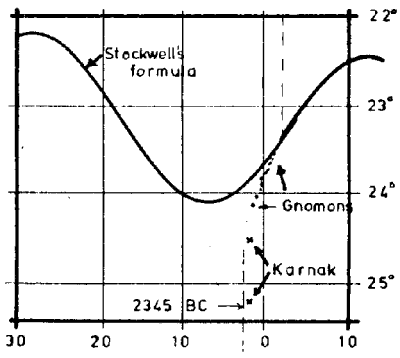 |
Science Frontiers ONLINE No. 30: Nov-Dec 1983 |
|
|
What happened in 2345 b.c.?
Australian astronomer G.F. Dodwell has analyzed the observational records com-piled for the many gnomons erected all over the civilized world during the past 4,000 years. Gnomons are vertical markers that cast shadows from which the local latitudes can be computed. (All one needs are the measurements of the shadow lengths on the longest and shortest days of the year.) The earth's tilt or obliquity-of-the-ecliptic may also be calculated from gnomon data -- and therein lies the anomaly. The tilt of the earth's axis is supposed to vary cyclically between 22 and 24.5� over a period of some 40,000 years due to the pulls of the moon, the sun, and the planets on the earth's equatorial bulge...
Tilt angles computed from ancient gnomon observations deviate markedly from the theoretical curve. The alignment of the ancient Egyptian temple at Karnak and other oriented sites extend the deviation toward the date 2345 B.C. Either the ancient observations were systematically in error all over the world or the earth's tilt angle changed in historical times.
(Bowden, M.; "The Recent Change in the Tilt of the Earth's Axis," Pamphlet No. 236, July 1983. Creation Science Movement.)
Comment. One would think that such startling data, compiled by a recognized astronomer, would be the subject of in-tense study in archeoastronomical circles; instead, it is an English creationst tract that discusses the subject.
 | Earth's tilt vs millenia from theory and ancient alignments. (Stockwell's formula) |